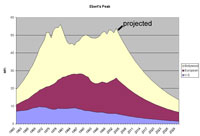Doing some reading this week for a piece about the inevitable decline in the availability of oil supplies, I ran across a lot of interesting literature in geophysics and energy economics suggesting the same line of argument applies to a wide range of societal goods. This has been widely discussed with respect to coal and natural gas as well, for example.
But perhaps the most interesting example I found was a little-known paper written in the early 1970s by a then-graduate student in film studies named Roger Ebert. Ebert, now famous as the film critic for the Chicago Sun-Times, argued that the supply of easy-to-make, quality films would reach an apex, leaving only lower-quality movies that could only be produced at significantly higher cost.
Ebert's analysis, which quantified the problem using his Modified Thumb Index (MTI) as a measure of the number of quality films produced per year, proved remarkably successful in predicting the peak of quality film production in the United States. Scholars generally agree that came in 1975, the year that produced such classics as One Flew Over the Cuckoo's Nest and Sexual Ecstasy of the Macumba. In the decades since, filmmakers have been forced to spend increasingly large sums of money in search of quality cinema, with decreasing marginal returns.
But like the analyses of energy resource production on which the work was loosely patterned, Ebert's analysis was unable to cope with a number of uncertainties that still plague efforts to quantify when the worldwide peak of quality film production will be reached.
The first uncertainty involves the discovery of untapped filmmaking talent in other parts of the world. As U.S. cinema declined in the latter half of the twentieth century, we saw a clear rise in European film. And Ebert was completely unprepared for the rise in Hong Kong action cinema (often called the "Jackie Chan effect") and the tremendous body of quality work produced in Bollywood.
Film scholars today still debate what we can expect in the coming decade. One school of thought, often referred to as the "cornucopians," argues that new discoveries of film talent, (as evidenced by the continuing success of Saturday Night Live alumni) and new development of new technology (see for example the rise of computer animation) will inevitably push out Ebert's peak.
Others (see the graph above) suggest that we may now be reaching a global Ebert's Peak, and that a decline in world cinema is inevitable.
Posted by John Fleck at November 13, 2004 01:51 PM